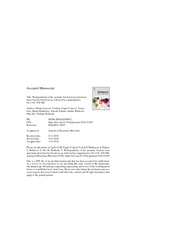Приказ основних података о документу
Biodegradation of the aromatic fraction from petroleum diesel fuel by Oerskovia sp. followed by comprehensive GC×GC-TOF MS
| dc.creator | Lješević, Marija | |
| dc.creator | Gojgić-Cvijović, Gordana D. | |
| dc.creator | Ieda, T. | |
| dc.creator | Hashimoto, S. | |
| dc.creator | Nakano, Takeshi | |
| dc.creator | Bulatović, S. | |
| dc.creator | Ilić, Mila V. | |
| dc.creator | Beškoski, Vladimir | |
| dc.date.accessioned | 2018-12-24T10:19:32Z | |
| dc.date.available | 2020-10-03 | |
| dc.date.issued | 2019 | |
| dc.identifier.issn | 0304-3894 | |
| dc.identifier.uri | https://cherry.chem.bg.ac.rs/handle/123456789/2800 | |
| dc.description.abstract | Polycyclic aromatic hydrocarbons (PAHs) from petroleum and fossil fuels are one of the most dominant pollutants in the environment. Since aromatic fraction from petroleum diesel fuel is mainly composed of PAHs, it is important to discover new microorganisms that can biodegrade these compounds. This article describes the biodegradation of the aromatic fraction separated from petroleum diesel fuel using the strain Oerskovia sp. CHP-ZH25 isolated from petroleum oil-contaminated soil. The biodegradation was monitored by gravimetry and GC × GC-TOF MS. An innovative method was applied to visualize degraded compounds in the data provided by a GC × GC-TOF MS. It was shown that Oerskovia sp. CHP-ZH25 degraded 77.4% based on gravimetric analysis within 30 days. Average rate of degradation was 14.4 mg/L/day, 10.5 mg/l/day and 4.0 mg/l/day from 0 to 10 day, 10–20 and 20–30 day, respectively. The order of PAH degradation based on decrease in peak volume after 30 days of incubation was as follows: dibenzothiophene derivatives gt benzo[b]thiophene derivatives gt naphthalene derivatives gt acenaphthene derivatives gt acenaphthylene/biphenyl derivatives gt fluorene derivatives gt phenanthrene/anthracene derivatives. Here we demonstrated that Oerskovia sp. CHP-ZH25 could potentially be a suitable candidate for use in bioremediation of environments polluted with different PAHs. © 2018 Elsevier B.V. | en |
| dc.relation | info:eu-repo/grantAgreement/MESTD/Integrated and Interdisciplinary Research (IIR or III)/43004/RS// | |
| dc.relation | Japan International Cooperation Agency (JICA) grassroot project “Capacity building for analysis and reduction measures of persistent organic pollutants in Serbia” | |
| dc.rights | embargoedAccess | |
| dc.rights.uri | https://creativecommons.org/licenses/by-nc-nd/4.0/ | |
| dc.source | Journal of Hazardous Materials | |
| dc.subject | Biodegradation | en |
| dc.subject | GC×GC-TOF MS | en |
| dc.subject | Oerskovia sp. | en |
| dc.subject | PAHs | en |
| dc.subject | Petroleum diesel fuel | en |
| dc.title | Biodegradation of the aromatic fraction from petroleum diesel fuel by Oerskovia sp. followed by comprehensive GC×GC-TOF MS | en |
| dc.type | article | |
| dc.rights.license | BY-NC-ND | |
| dcterms.abstract | Љешевић, М.; Иеда, Т.; Хасхимото, С.; Накано, Т.; Булатовић, С.; Илић, М.; Бешкоски, Владимир; Гојгић-Цвијовић, Г.; | |
| dc.citation.volume | 363 | |
| dc.citation.spage | 227 | |
| dc.citation.epage | 232 | |
| dc.identifier.wos | 000449891900025 | |
| dc.identifier.doi | 10.1016/j.jhazmat.2018.10.005 | |
| dc.citation.other | 363: 227-232 | |
| dc.citation.rank | aM21 | |
| dc.description.other | Supplementary material: [http://cherry.chem.bg.ac.rs/handle/123456789/2950] | |
| dc.description.other | This is the peer review version of the following article: Lješević, M.; Gojgić-Cvijović, G.; Ieda, T.; Hashimoto, S.; Nakano, T.; Bulatović, S.; Ilić, M.; Beškoski, V. Biodegradation of the Aromatic Fraction from Petroleum Diesel Fuel by Oerskovia Sp. Followed by Comprehensive GC×GC-TOF MS. Journal of Hazardous Materials 2019, 363, 227–232. [https://doi.org/10.1016/j.jhazmat.2018.10.005] | |
| dc.type.version | acceptedVersion | en |
| dc.identifier.scopus | 2-s2.0-85054440659 | |
| dc.identifier.fulltext | https://cherry.chem.bg.ac.rs/bitstream/id/6405/10.1016@j.jhazmat.2018.10.005.pdf |


